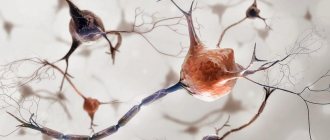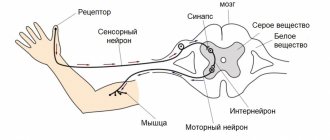Among a number of aphasic disorders, acoustic-mnestic disorders occupy a special place.
What acoustic-mnestic aphasia is, why and under what problems does this memory lesion occur in the body, what disorders it leads to, what are the features of diagnosis and correction will be discussed below.
What is the reason?
The appearance of the disorder is the result of damage to certain areas of the cerebral cortex. Pathology occurs in the temporal part of the dominant hemisphere , in its mid-posterior sections. These are the so-called Brodmann cytoarchitectonic areas 21 and 37. For most people, the left hemisphere is dominant.
Disruption of the functioning of these departments can occur due to deterioration of blood circulation in this place, inflammatory processes, and trauma.
As a result of the latter, the integrity of the brain structures is disrupted or compression occurs:
- Stroke .
The most common factor in this type of aphasia. An ischemic stroke leads to insufficient blood supply and oxygen starvation of the cerebral cortex. In a hemorrhagic stroke, blood leaking from damaged vessels compresses the brain tissue. - Traumatic brain injuries . The damage received during the injury itself is accompanied by swelling, which puts pressure on the brain structures. An inflammatory process may also begin.
- Intracerebral tumors . Any formations (both malignant and benign) lead to disruption of brain activity due to increasing pressure on neighboring areas and the vessels from which they feed. If the tumor grows into the brain structure itself, the latter is destroyed.
- Diseases of an infectious nature . Any inflammation of the brain substance or its membranes (encephalitis, meningitis, cerebral abscesses) causes dysfunction of neurons that participate in the process of speech formation. Inflammation leads to swelling and compression, which leads to disruption of connections between neurons.
- Progressive degenerative processes . A number of diseases (Alzheimer's disease, Pick's disease, Schilder's leukoencephalitis), which are accompanied by damage to certain hemispheric lobes and destruction of the myelin sheath of nerve fibers, in the initial stages cause acoustic-mnestic dysfunction.
Pathogenesis
In people suffering from acoustic-mnestic aphasia, auditory-verbal memory is impaired. Presumably, this is due to excessive inhibition of auditory-verbal traces.
That is, tracking activity is not disrupted (traces are recorded and not forgotten), but is slowed down and drowned out by further information. It is easier for the patient to repeat a single word than a series. In addition, a person’s auditory-verbal memory capacity decreases, which aggravates the situation.
Often, when the 37th Brodmann area is damaged, its connection with the structures of the occipital lobe, which carry an optical-gnostic load, is disrupted, i.e. are responsible for visual and cognitive perception, which is where acoustic-mnestic aphasia arises.
Clinical manifestations
Acoustic-mnestic aphasia is a pathology characterized by dissociation of a person’s ability to repeat complex phrases and individual words. Impaired auditory-verbal memory leads to the fact that out of the entire sentence spoken to him, the patient can repeat only single words. Primary, the patient associates this with the fact that he did not hear the whole phrase or could not remember it. When repeating what was said, the situation does not change - the person repeats only one word.
This symptom is most pronounced when talking with several interlocutors and using complex sentences. The mechanism of the disorder is associated with a person’s inability to reproduce heard information due to damage to the middle temporal gyrus.
Aphasia cannot be detected during normal conversation with a person. To do this, it is necessary to conduct a comprehensive study of its speech functions.
When speaking independently, the patient experiences difficulty finding words. Patients begin to replace “difficult” words with analogues that do not always fit in meaning. This manifestation of verbal paraphasia is accompanied by a decrease in speech literacy - a person incorrectly uses prepositions, inflects nouns and verbs. When performing tasks to compose a story or repeat what was heard, the violations become stronger.
The disorder is accompanied by writing impairments. When taking dictation, low literacy and paucity of sentences are noted. When writing, a person asks to repeat what was said and simplifies what he heard to individual words and their combinations. If the patient is asked to read a text, difficulties arise when reading long sentences. In addition to these symptoms, impairments in counting and other cognitive functions are noted.
Main symptoms and central mechanism of pathology
Impressive speech is impaired, but not grossly, i.e. understanding of what is heard suffers . It is difficult for the patient to correlate the visual image of an object and its linguistic shell, and difficulties arise in understanding the meaning of the statement.
A distinctive feature of acoustic-mnestic aphasia is the following: when a person hears new words, he forgets those that were heard before. This makes it difficult to understand the overall meaning of the statement.
It is difficult for the patient to unravel the hidden subtext of what he heard, allegories, and allegorical references . At the same time, short, situational statements are easy to understand. The situation is different with the comprehension of detailed speech production.
In severe acoustic-mnestic aphasia, spontaneous speech consists of short phrases and a poor vocabulary. It is difficult for the patient to find the right word. With a mild degree, speech is more developed, but it is difficult to make statements with subordinate constructions, participial and participial phrases.
In addition, the symptomatic picture of acoustic-mnestic aphasia is characterized by verbal paraphasia, difficulty understanding speech in conditions of increased complexity (fast pace, simultaneous presentation of two speech messages), difficulty writing from dictation, and a symptom of alienation of the meaning of a word.
Which symptoms are not related to this pathology:
- phonemic hearing impairment;
- impairment of sound discrimination;
- literal paraphasias;
- incoherent, unproductive conversational speech.
Read about the symptoms of other memory disorders: manifestations of hyperthymesia, signs of deja vu, jamevu and presquevu.
Acoustic-mnestic aphasia
Localization of the lesion. Primary defect. Neuropsychological signs. Speech status of the patient. Violation of writing, reading, counting, understanding speech, thought processes. Features of visual representations in patients of this group.
Acoustic-mnestic aphasia occurs with damage to the middle and posterior parts of the temporal region (A. R. Luria, 1969, 1975; L. S. Tsvetkova, 1975) (fields 21 and 37.). A. R. Luria believes that it is based on a decrease in auditory-verbal memory, which is caused by increased inhibition of auditory traces. With the perception of each new word and its awareness, the patient loses the previous word. This disorder also manifests itself when repeating a series of syllables and words. In this form of aphasia, the premotor and postcentral zones, as well as phonemic hearing, are preserved.
The auditory-verbal memory of these patients is extremely inert.
A characteristic dissociation is between the relatively intact ability to repeat individual words and the impaired ability to repeat three or four unrelated words (for example: hand
-
home
-
sky;
spoon -
sofa
-
cat;
forest -
house
-
ear
etc.). Typically, patients repeat the first and last word, in more severe cases - only one word from a given series of words, explaining this by the fact that they did not remember all the words. When listening again, they also do not retain either their sequence or omit one of them.
Having memorized a series of words, patients cannot repeat them if they are presented in a different order. They replace the necessary words with a perseverative repetition of words already spoken. If you ask the patient to repeat a series of words after a pause filled with any questions, then he is not able to remember them.
Impaired speech understanding. Impaired auditory-verbal memory capacity leads to difficulties in understanding long, polysyllabic statements consisting of five to seven words: a person can indicate or give the wrong object in question, he becomes acoustically-mnestic disoriented, has difficulty navigating a conversation with two or three interlocutors, “switches off” in difficult speech situations, cannot attend reports, lectures, gets tired when listening to music and radio broadcasts. Patients understand the meaning of individual words well and do not show any signs of “alienation” of the meaning of the word. However, with an increase in the volume of verbal information, as in a patient with acoustic-gnostic aphasia, the phenomenon of “alienation” of the meaning of a word may arise.
Impaired speech perception is also uniquely expressed in the equalization or confusion of stress within a word, which results in either an alienation of the meaning of the word or its pronunciation. Thus, it is typical to pronounce words in which an unstressed syllable becomes a full-voiced stressed syllable, and a stressed syllable is reduced to an unstressed one. For example, patient R., naming object pictures, said: “Factory... something is wrong... is there such a word?” The speech therapist let the patient listen to the word, wrote it down in a notebook, after which the patient said joyfully: “Well, of course, the plant... otherwise for some reason water... after water... it turned out to be nonsense.”
Expressive speech impairment. Active speech: In this form of aphasia, expressive speech is characterized by difficulty finding the words needed to organize an utterance. Difficulties in finding words are explained by the impoverishment of visual ideas about the subject, the weakness of the optical-gnostic component. Semantic blurring of the meaning of words leads to the occurrence of abundant verbal paraphasia, rare literal substitutions, and the merging of two words into one, for example, “knife” (knife + fork).
Speech in acoustic-mnestic aphasia, as in acoustic-gnostic aphasia, retains its pronounced predicative character. They do not have articulatory difficulties, they are not only verbose, but also hyperactive. The speech is abundant and uninformative. But in contrast to acoustic-gnostic aphasia, the utterance in acoustic-mnestic aphasia is more complete; there is no “speech hash” in speech.
Naming function. Perseverations in patients with acoustic-mnestic aphasia are observed only when repeating and naming a series of words that are not connected by meaning, which still does not prevent them from understanding the meaning of sentences and texts, the semantic subtext of fables (A. R. Luria).
Reading and writing impairment. With acoustic-mnestic aphasia, in written speech, more than in oral speech, the phenomena of expressive agrammatism appear, i.e., confusion of prepositions, as well as inflections of verbs, nouns and pronouns, mainly in gender and number. The nominative side of written speech turns out to be more preserved, since patients have more time to select words, choose synonyms, as well as phraseological units that help “recall” the necessary words; literal paraphasias of the acoustic type (a mixture of voiced and voiceless phonemes) are occasionally observed. When recording text from dictation, patients experience significant difficulties in retaining even a phrase consisting of three words in their auditory-verbal memory. At the same time, they are asked to repeat each fragment of the phrase.
It is significantly difficult to understand the text being read. This is because printed text consists of long sentences. Retention of a readable text in memory also requires the preservation of auditory-verbal memory.
Account violation. Defects in auditory-verbal memory also affect when solving arithmetic examples, in which part of the operations must be retained in the mind, that is, remembered. For example, when adding the numbers 27 and 35, the patient writes 2 and says “one in mind.” Even if the unit is written near the example, he forgets to add it to subsequent terms.
Thus, in acoustic-mnestic aphasia, impairment of auditory-verbal memory secondarily complicates the normal implementation of writing, reading and counting.
Speech and mental operations are difficult. Patients freely perform mental operations that include an element of clarity, i.e., operations with geometric relationships, a task of constructive praxis, and experience significant difficulties in the transition to systematic sequential operations that require the participation of speech connections. Thus, patients freely lay out a series of plot pictures, but cannot determine their sequence by arranging them in accordance with the numbering, if they are obviously laid out in a different sequence. Attempts to include oral speech in these operations do not facilitate, but complicate speech-thinking activity
Weakness of visual perception. Patients, when depicting any objects, omit or do not draw details that are significant for identifying these objects. So, they may not finish drawing the spout of a teapot, the comb of a rooster, or the handle of a cup. It is characteristic that patients do not complete drawings of those elements that, on the one hand, are specific to the objects depicted, and on the other hand, are associated with the ambiguity of the word (the words “nose”, “comb”, “handle”, etc. are ambiguous). The patient draws an indeterminate bird instead of a rooster, something similar to a sugar bowl instead of a teapot, a bowl or glass instead of a cup, etc.
Semantic aphasia
Localization of the lesion. Primary defect. Neuropsychological signs. Speech status of the patient. Violation of writing, reading, counting, understanding speech, thought processes.
Semantic aphasia occurs when there is damage to the parieto-occipital region of the speech-dominant hemisphere (field 39). When the parieto-occipital (or posterior inferior parietal) parts of the left hemisphere of the brain are damaged, the smooth syntagmatic organization of speech is preserved, no searches for the sound composition of a word are noted, and there are no phenomena of decreased auditory-verbal memory or impaired phonemic hearing.
With semantic aphasia, specific amnestic difficulties are observed when searching for the right word or arbitrarily naming an object, when patients with difficulties in finding a lexical paradigm turn to describing the functions and qualities of this object by syntagmatic means, i.e., they do not replace one word with another (verbal paraphasia), but replace word in a whole phrase, they say: “Well, this is what they write with,” “... this is what they cut with,” etc., and on the other hand, there is complex impressive agrammatism characteristic of this form of aphasia.
Impaired understanding. Impaired understanding of complex semantic and grammatical relationships between words expressed by prepositions and inflections is called impressive agrammatism. With semantic aphasia, the understanding of ordinary phrases that convey “communication of events” is preserved. Patients understand well the meaning of individual prepositions, freely place a pencil under a spoon or spoon to the right of a fork, but find it difficult to arrange three objects according to the instructions: “Put the scissors to the right of the fork and to the left of the pencil.” They experience even greater difficulties when arranging geometric figures, unable to solve such a logical-grammatical problem as drawing a cross under a circle and above a square, and cannot navigate comparative phrases like: Kolya is taller than Misha and shorter than Vasya. Which one is the tallest? Who's the shortest?
They have the same difficulties when understanding comparative phrases with adverbs
further
-
closer, left
-
right
, etc.
The main manifestation of speech pathology in this form of aphasia is impressive agrammatism, that is, a violation of the understanding of complex semantic and grammatical relationships between words expressed by prepositions and inflections.
The greatest difficulties arise with semantic aphasia in solving logical-grammatical phrases that convey “communication of relationships” such as “father’s brother” - “brother’s father”, which can only be solved by correlating with certain semantic categories: uncle
-
brother
-
father.
With semantic aphasia, the understanding of metaphors, proverbs, sayings, and catchwords is lost, and figurative meaning is not found in them. Thus, the metaphors “heart of stone”, “iron hand”, the proverb “Don’t spit in the well, you’ll need some water to drink” are understood in a literal, concrete sense.
Violation of oral and written speech. Expressive speech in semantic aphasia is characterized by the preservation of the articulatory side of speech. However, pronounced amnestic difficulties may be observed; prompting the first syllable or sound of a word helps the patient. The words are replaced by a description of the function of the object: “Well, this is what you look at the street through” or “This is what tells the time.”
According to A.R. Luria, the basis of amnestic difficulties in semantic aphasia is a violation of the so-called “law of force”, which normally allows one to accurately select a word from a series of words that are close in categorical attribution and in meaning. Violation of that “law of force” seems to block the search for a word as a paradigm in a certain semantic field, and therefore, patients resort to the syntagmatic method of describing the function or categorical affiliation of an object: “That which they eat fish with,” “That which they cut (they write etc.)".
Verbal paraphasias are not typical for semantic aphasia, since patients do not replace one paradigm with another.
Written speech is characterized by poverty, stereotypical syntactic forms, many complex and complex sentences, and the use of adjectives is reduced.
Account violation. In semantic aphasia, gross violations of counting operations are observed. Patients confuse the direction of action when solving arithmetic examples, experience difficulty in moving through tens, and have difficulty writing multi-digit numbers by ear. For example, instead of the number 1081, a person writes 1801, 1108, since it is difficult to determine the digit capacity of the number. Counting disorders manifest themselves in difficulties in understanding the text of problems, since they include the same logical elements more
-
less, further
-
closer, by as much, how many times,
etc.
In both right-handers and the majority of retrained left-handers, semantic aphasia occurs when the left hemisphere is damaged and is a persistent speech disorder.
Diagnostic measures
Diagnosis of the acoustic-mnestic form of aphasia requires the participation of different specialists and a set of studies. The patient should be consulted by a neurologist, psychiatrist, speech therapist, aphasiologist, and neuropsychologist. Based on the collected anamnestic data, a diagnosis is made.
Neurological examination
The neurological basis of the diagnosis is the identification of pathology of the cranial nerves, the presence of spastic hemiparesis, and impaired reflexes. A cognitive examination is also carried out to rule out mental disorders.
Speech examination
Features of speech activity are identified by a speech therapist and aphasiologist . When examining a patient with acoustic-mnestic dysfunction, verbal paraphasia, dyslexia, dysgraphia, and agrammatisms in speech will be detected.
Specialists will also pay attention to the level of auditory-verbal memory . The patient is asked to remember and reproduce a chain of ten short words that are not related to each other. Often the subject remembers only 1 word from the proposed ones, the last one.
Another task: 2 groups of lexical series of 3 words each are given. They also need to be remembered and retold. Most often, patients fail to cope with the task: they group words incorrectly and find it difficult to remember what exactly was called.
To examine auditory-verbal memory for a text, you are asked to listen to a short passage, retell it and answer questions. To record optical-gnostic disorders, the patient is asked to draw, for example, a cup or a teapot. If there is a pathology, the images will be missing details: a handle or spout.
Brain MRI
Magnetic resonance imaging will show the presence of tumor formations, foci of inflammation, degenerative changes, and traumatic injuries.
Vascular studies
To study blood vessels, ultrasound, duplex scanning, and MR angiography are prescribed . These studies make it possible to confirm or refute cerebrovascular pathology. They also show the characteristics of cerebral, collateral circulation, and the presence of vascular occlusion.
Lumbar puncture
To check for suspected neuroinfection, a lumbar puncture is performed. During the procedure, cerebrospinal fluid is taken from the patient. Laboratory examination of the material will show whether an inflammatory process is present, determine the pathogen, the presence of cancer cells, and signs of hemorrhage.
Differential diagnosis
When examined superficially, the symptoms of acoustic-mnestic disorder can be confused with signs of other speech disorders. Therefore, it is important to pay special attention to collecting anamnesis.
Thus, the difference between this type of aphasia and motor one lies in the activity of spontaneous speech. In acoustic-gnostic aphasia, as opposed to mnestic aphasia, the utterance is less complete and there are literal paraphasias. It is also necessary to distinguish between aphasia and cognitive impairment.
Diagnosis for aphasia
Due to the fact that this disease does not have a unified classification or an accurate understanding of the pathogenesis, it can be difficult for a neurologist to diagnose the type of aphasia. Diagnosis is carried out by excluding other mechanisms of disorders and determining the nature of the cerebral lesion. Usually the doctor prescribes the following diagnostic measures:
- MRI
- CT
- Ultrasound of cerebral vessels, etc.
To understand whether a person is sick or not, it is often enough to ask him to talk about himself. Ask your child to read and tell what he read about. Questions to understand logical-grammatical and spatial relationships help in diagnosis. For example, who is related to whom and follows whom, etc. These simple tests can even be used at home if pathology is suspected in adults or children.
But you can’t do without an examination at a medical institution. This will help confirm or refute the diagnosis.
Treatment and correction
Treatment of the general disease that is the root cause of aphasia should be carried out in parallel with a corrective effect on the patient’s speech.
The consequences of a stroke require thrombolytic or hemostatic therapy. Surgery and radiotherapy are prescribed for tumor processes or brain hematomas. Antibiotic therapy is carried out to eliminate neuroinfectious diseases.
Speech therapy classes, exercises
It is advisable to start exercising from the moment the disease is diagnosed . Initially, the patient is asked to rely on visual perception, after which small dictations are carried out by ear. The complexity of the proposed exercises should gradually increase.
In classes with a speech therapist, work is carried out to expand the scope of speech perception. For this purpose, the following tasks are given:
- Follow the 2-3 step instructions (copy down the words, first grouping them by topic).
- Show parts of objects that are presented in groups of two or three.
- Listen to the text and answer the questions.
It is useful for a person suffering from an acoustic-mnestic form of aphasia to memorize and recall speech sequences, poems, songs, and compose sentences using reference words. To overcome the difficulty in choosing words for a statement, you can compare synonymous series, antonymic pairs, and clarify the meaning of lexemes.
Expressive speech is trained in the following tasks:
- Make up a story based on the pictures.
- Retell the text according to plan.
- Write a letter.
Drug therapy
Therapeutic measures for acoustic-mnestic aphasia involve restoring the functioning of neurons and connections between them. Treatment works best when stimulating metabolic processes in the brain structures.
The doctor prescribes nootropics to the patient (Piracetam, Nootropil, Memotropil, Noocetam, Noopept, Pantogam, Mexidol), neurometabolic drugs (gamma-aminobutyric acid), as well as drugs to improve vascular function (Vinpocetine, Cavinton, Bravinton).
Aphasia and apraxia: mechanisms
Aphasia
Apraxia is a violation of purposeful movements and actions while the elementary movements that constitute them are preserved. These two conditions can occur together. The mechanism is like this:
- When the lower parts of the postcentral gyrus of the dominant hemisphere are damaged, oral apraxia develops.
- Usually in combination with motor aphasia: the patient cannot find the positions of the speech apparatus necessary to pronounce the corresponding sounds, sounds that are close in articulation are mixed, and writing is impaired.
- When the frontal lobe is damaged, frontal apraxia occurs: the breakdown of complex movement skills and action programs.
- The patient is prone to echopraxia (repeats the movements of the examiner) or to stereotypical movements that he does not notice.
Such cases are very complex and therefore the intervention and help of a specialist is simply necessary. It is important to follow all the recommendations of the speech therapist and neurologist. The prognosis for treatment is usually good if the disturbances did not occur during inoperable tumor processes or progressive degenerative diseases. Prevention of cardiovascular diseases, head injuries, infections, and various carcinogenic effects is also important.
Forecast and prevention of the problem
Forecasts for the acoustic-mnestic type of aphasia can be made by knowing the genesis of the disease and taking into account the time when treatment was started.
Often, after strokes, traumatic brain injuries, or encephalitis, people restore speech function. However, this is preceded by a long therapeutic period.
If aphasia remains undiagnosed and is not subject to corrective action, then speech pathology will become persistent. The most unfavorable prognosis is given for aphasia resulting from a tumor or damage to brain structures .
Preventive measures include timely treatment of cerebrovascular diseases, identification of oncological factors, prevention of injuries, and strengthening of the immune system.
The acoustic-mnestic form of aphasic disorder does not always mean a final verdict . If the diagnosis is made correctly and treatment is started in a timely manner, the patient has a high chance of maintaining full-fledged activity.
Prevention of violations
Preventive measures are aimed at the primary prevention of diseases that can lead to speech disorders. Neurologists make a number of general recommendations:
- use protective helmets during professional activities and some sports;
- if you have diseases of the internal organs, for example, diabetes mellitus or atherosclerosis, promptly seek medical help and follow the instructions of your doctor;
- follow the principles of a healthy diet: give up fast food, fried or smoked foods, add fruits, vegetables, lean meat and other healthy foods to your diet;
- regularly engage in sports - cardio training and exercises in the gym;
- Avoid drinking alcohol and smoking.
If you experience difficulty finding words or other symptoms, you should immediately seek medical help.









